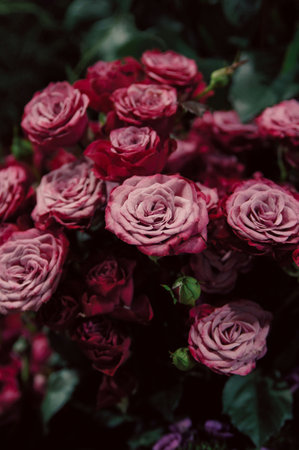Understanding Rose Varieties Suitable for the UK Climate
When it comes to planting roses in the UK, selecting the right variety is crucial for success. The British climate, characterised by mild temperatures and frequent rainfall, allows a diverse range of roses to flourish. However, certain cultivars are particularly well-suited to local conditions. Hybrid teas are prized for their classic shape and vibrant colours, making them a favourite in formal gardens. Floribundas, known for their clusters of blooms and extended flowering season, provide excellent colour throughout summer and autumn. For those seeking low-maintenance options, shrub roses and English roses (such as those bred by David Austin) combine disease resistance with old-fashioned charm and fragrance.
Choosing the Right Rose for Your Garden Conditions
The success of your rose garden also depends on matching the rose type to your specific garden environment. For exposed or windy sites, consider hardy varieties like rugosa roses, which tolerate salt-laden air and poor soils. In shaded gardens, look for shade-tolerant varieties such as ‘Zephirine Drouhin’. If space is limited, compact patio or miniature roses offer beauty without overwhelming smaller plots or containers. Always check labels for information on height, spread, and disease resistance to ensure the best fit for your site.
Popular UK Rose Cultivars
Among the top choices for UK gardeners are cultivars like ‘Gertrude Jekyll’, renowned for its strong scent and repeat flowering; ‘Iceberg’, valued for its prolific white blooms; and ‘Queen Elizabeth’, an enduring floribunda favourite. These varieties not only perform reliably in typical British weather but also bring lasting colour and structure to borders, beds, and even containers.
Expert Tip: Visit Local Rose Gardens
If you are unsure which variety to choose, visit local public rose gardens or specialist nurseries across the UK. Observing established plants in real conditions will help you make informed decisions tailored to your region’s climate and soil.
Preparing Your Garden for Planting
Before introducing roses to your UK garden, it is essential to create the right environment for them to thrive. This process involves careful site selection, a thorough assessment of your soil, and proper ground preparation tailored to local British conditions.
Selecting an Appropriate Location
Roses flourish best when they receive at least six hours of direct sunlight each day. Choose a spot that is sheltered from strong winds yet has good air circulation to reduce the risk of fungal diseases common in the UK’s damp climate. Avoid planting roses too close to large trees or shrubs, as these can compete for nutrients and water.
Assessing Soil Quality
The success of your rose garden largely depends on soil type and condition. Roses prefer well-drained loam with a pH between 6.0 and 7.0. Conduct a simple soil test to determine pH and nutrient levels; most garden centres offer kits suitable for home use. If your soil is heavy clay or sandy, amending it will be necessary.
Soil Assessment Checklist
| Soil Feature | Ideal Condition for Roses | Improvement Tips |
|---|---|---|
| Drainage | Well-drained, not waterlogged | Add organic matter or grit to improve structure |
| pH Level | 6.0–7.0 (slightly acidic to neutral) | Lime to raise pH, sulphur to lower if required |
| Nutrient Content | Rich in organic material | Incorporate compost or well-rotted manure |
Preparing the Ground
Start by clearing the area of weeds and debris. Dig over the soil to a depth of at least 30cm (12 inches), breaking up any clods as you go. Incorporate generous quantities of organic matter such as compost or well-rotted farmyard manure; this improves fertility and drainage, both critical for healthy rose growth in British gardens.
Tip:
If you are replacing old roses with new ones, consider changing the soil or treating it with mycorrhizal fungi to avoid rose replant disease, which can hinder new plant development.

3. When and How to Plant Roses
Step-by-Step Instructions for UK Gardeners
Planting roses in the UK requires careful timing and technique, particularly when considering the country’s unique climate. Both bare root and container-grown roses have specific optimal planting periods and methods that ensure healthy establishment and vigorous growth.
Best Time to Plant Roses
Bare Root Roses
The ideal time to plant bare root roses in the UK is from late autumn (November) through early spring (March), when the plants are dormant. Avoid planting during periods of heavy frost or waterlogged soil, which can hinder root development.
Container Roses
Container-grown roses offer greater flexibility and can be planted at any time of year, provided the ground is not frozen or excessively dry. However, spring and autumn remain preferable, as milder temperatures reduce transplant shock and promote steady root growth.
Step-by-Step Planting Method
- Select the Right Location: Choose a spot with at least six hours of sunlight per day, sheltered from harsh winds yet well-ventilated to prevent disease.
- Prepare the Soil: British soils vary; enhance clay-heavy or sandy soils by digging in plenty of well-rotted organic matter. Aim for a pH between 6.0 and 6.5 for optimal results.
- Dig the Hole: Create a hole twice as wide and deep as the rose’s root ball or spread roots. Loosen the base to encourage downward root growth.
- Position the Rose: For bare root roses, spread roots evenly over a small mound of soil at the base. For container roses, gently tease out roots if they appear pot-bound. In all cases, ensure the graft union (the swollen section on the stem) sits just below soil level—this protects against frost common in British winters.
- Backfill and Firm: Fill in with excavated soil mixed with compost, firming gently as you go to eliminate air pockets without compacting too tightly.
- Water Thoroughly: Give your newly planted rose a generous soak to settle the soil around its roots, especially important during drier spells or unpredictable rainfall typical of UK weather.
Adapting to British Weather Patterns
UK gardeners should monitor local weather forecasts closely. Delay planting if prolonged wet conditions threaten waterlogging or if hard frosts are imminent. Mulch around newly planted roses with organic matter to insulate roots against cold snaps and retain moisture during dry periods, supporting strong establishment regardless of regional variations in weather.
4. Caring for Newly Planted Roses
Once your roses are securely in the ground, appropriate aftercare is essential to ensure robust growth and a vibrant display of blooms. The unpredictable UK climate and diverse soil conditions require a tailored approach to watering, mulching, and feeding.
Best Practices for Watering
Newly planted roses need consistent moisture to establish strong roots, but overwatering can be detrimental, especially in heavy clay soils common in many British gardens. It’s important to monitor local rainfall and adjust watering accordingly.
| Soil Type | Watering Frequency | Tips |
|---|---|---|
| Sandy | 2-3 times per week | Drains quickly—check moisture levels regularly |
| Clay | 1-2 times per week | Retains water—avoid waterlogging roots |
| Loam | 1-2 times per week | Holds moisture well—ensure even soaking |
General Guidance:
- Water early in the morning or late afternoon to reduce evaporation.
- Aim for the base of the plant to keep foliage dry and prevent disease.
- During hot, dry spells, increase frequency as required.
- If using rainwater from a butt, ensure it is free from contaminants.
Mulching for Moisture and Weed Control
A good layer of mulch helps conserve soil moisture, suppresses weeds, and improves soil structure—especially useful during unpredictable British summers. Apply a 5–8cm (2–3in) thick layer around each rose bush, keeping it a few centimetres away from stems to prevent rot.
| Mulch Type | Main Benefit |
|---|---|
| Well-rotted manure | Nutrient-rich; improves soil fertility and texture |
| Bark chips | Excellent for weed suppression; long-lasting cover |
| Garden compost | Adds organic matter; boosts beneficial soil microbes |
| Straw or leaf mould | Good for moisture retention; breaks down gradually |
Initial Feeding After Planting
Avoid heavy feeding at planting time; excessive nutrients can burn young roots. After about four weeks, when signs of new growth appear, apply a balanced rose fertiliser such as a granular feed high in potash (K) to support flower formation. Always follow manufacturer recommendations for application rates.
Feeding Tips:
- If you incorporated well-rotted manure at planting, delay additional feeding until early summer.
- Avoid high-nitrogen feeds initially as they promote leafy growth over flowers.
- An annual top-dressing in spring with slow-release fertiliser sets up healthy growth for the season ahead.
- Lime may be beneficial in acidic soils (common in some parts of the UK); test pH if unsure.
Summary Table: Early Rose Care Essentials (UK)
| Cultural Practice | Main Consideration (UK) |
|---|---|
| Watering | Tune frequency to rainfall and soil type; avoid waterlogging in wet spells. |
| Mulching | Add after planting; replenish annually for best results. |
| Feeding | Start lightly after initial root establishment; use rose-specific fertilisers. |
The foundation laid during these first weeks will influence your roses’ health throughout the season. With attentive watering, effective mulching, and measured feeding—adapted to your unique garden conditions—you’ll set your roses on the path to thriving displays year after year.
5. Pruning and Ongoing Maintenance
Seasonal Pruning Techniques
Proper pruning is fundamental to cultivating healthy, floriferous roses in UK gardens. The optimal time for pruning most rose varieties is late winter to early spring—typically from late February to March—when the risk of severe frost has diminished but before new growth begins in earnest. Begin by removing dead, diseased, or damaged wood with clean, sharp secateurs. Cut just above an outward-facing bud at a 45-degree angle to encourage open growth and good air circulation. For hybrid teas and floribundas, reduce stems to about 20–30cm (8–12 inches) from the base, while shrub and climbing roses generally require less severe cutting, focusing on shaping and thinning crowded areas.
Pest Monitoring and Management
Regular inspection for common UK rose pests such as aphids, black spot, powdery mildew, and rust is essential throughout the growing season. Early detection allows for effective intervention with horticultural soaps or environmentally friendly pesticides if necessary. Encourage natural predators like ladybirds and lacewings by maintaining a diverse garden ecosystem. Remove any affected leaves promptly and dispose of them in household waste rather than composting, to prevent the spread of disease.
Routine Maintenance Tasks
Beyond pruning and pest control, roses benefit from consistent care throughout the year. Water deeply during dry spells, especially for newly planted specimens; aim to keep soil moist but not waterlogged. Apply a balanced rose fertiliser in early spring and again after the first flush of blooms to support robust growth and repeat flowering. Mulch annually with well-rotted manure or compost in late winter to conserve moisture and suppress weeds. Deadhead spent blooms regularly to encourage further flowering and maintain a tidy appearance.
Best Practices for UK Gardeners
Adhering to established British horticultural practices ensures your roses thrive in local conditions. Always use clean tools, wear gardening gloves, and select cultivars suited to your region’s climate and soil type. With attentive seasonal care—including vigilant pruning, pest monitoring, and ongoing maintenance—UK gardeners can enjoy vigorous, long-lived rose displays year after year.
6. Troubleshooting Common Problems
Even with the best care, roses in UK gardens can sometimes encounter a range of challenges. Early identification and effective intervention are key to maintaining healthy, flourishing plants. Below, we outline the most common rose issues faced by British gardeners and offer practical, locally recommended solutions.
Black Spot Disease
Identification: Black spot is a prevalent fungal disease in the UK, characterised by round black spots with fringed edges on leaves, leading to yellowing and premature leaf drop.
Solution: Remove and dispose of affected leaves promptly to prevent spread. Apply a fungicide approved for use in the UK—such as those containing myclobutanil or triticonazole—according to manufacturer’s instructions. Enhance air circulation by pruning congested growth and avoid overhead watering.
Pest Infestations
Aphids
Identification: Clusters of greenfly or blackfly on new shoots and buds.
Solution: Encourage natural predators like ladybirds and lacewings. For severe infestations, spray with an insecticidal soap or a pyrethrum-based product widely available in British garden centres.
Rose Slug Sawfly
Identification: Skeletonised leaves caused by small, green larvae.
Solution: Hand-pick larvae where possible and use an organic pesticide such as neem oil if infestations persist.
Mildew Issues
Powdery Mildew: Appears as white, powdery patches on leaves and stems during warm, dry spells.
Treatment: Improve air flow around plants by strategic pruning. Water at the base rather than overhead. Use sulphur-based fungicides recommended for UK use if needed.
Nutrient Deficiencies
Pale or yellowing leaves may indicate a lack of essential nutrients, particularly magnesium or iron.
Remedy: Feed roses with a balanced fertiliser formulated for roses—many UK brands offer suitable options—and consider adding Epsom salts for magnesium deficiency as per label guidance.
General Preventative Tips
- Regularly inspect your roses for early signs of stress or infection.
- Maintain good hygiene by removing fallen leaves and debris from around the base.
- Select disease-resistant varieties when planting new roses to reduce future problems.
Tackling rose problems swiftly and using methods recommended by UK gardening experts will help ensure your roses remain robust and beautiful season after season.


